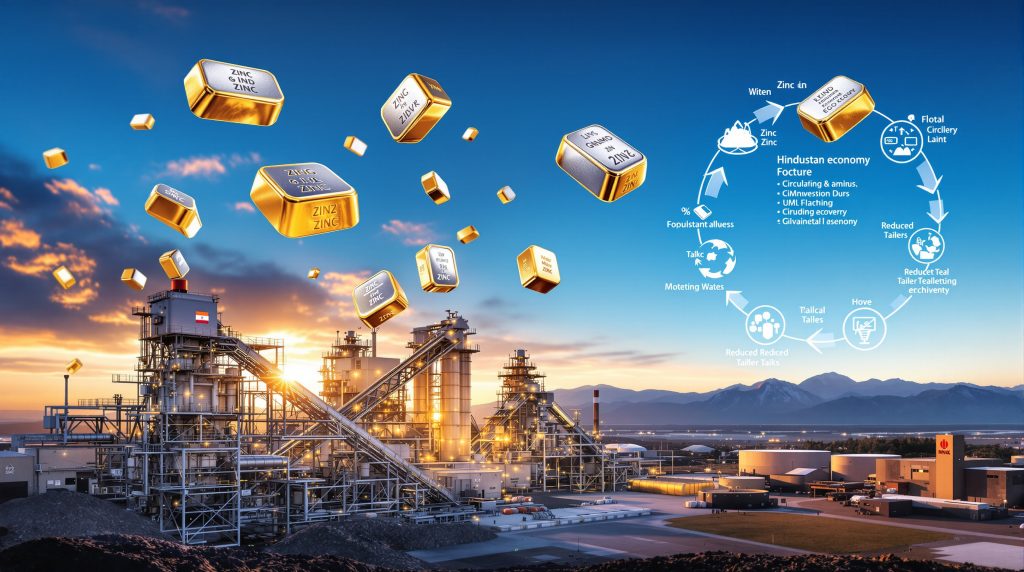Understanding Hindustan Zinc's $438 Million Tailing Reprocessing Investment
Hindustan Zinc's recent announcement of a 38.23 billion rupees ($437.5 million) investment to construct a new tailing reprocessing facility marks a significant development in the mining industry's approach to resource efficiency and sustainability. This strategic investment, revealed on May 13, 2025, focuses on recovering valuable metals from tailing dumps—the waste material that remains after initial ore processing.
The new facility is designed with an impressive 10 million tons per annum processing capacity, positioning it as a major component in the company's broader expansion strategy. By targeting previously discarded materials, Hindustan Zinc aims to enhance its production capabilities while addressing environmental considerations that have become increasingly important in modern mining sustainability transformation.
This project represents a forward-thinking approach to resource utilization, with implementation expected to significantly boost the company's overall mineral recovery rates while establishing new operational benchmarks in the industry.
The Technology Behind Tailing Reprocessing Plants
Tailing reprocessing plants utilize specialized equipment and advanced processes designed to extract residual metals from previously processed material. Unlike traditional mining operations that focus on extracting metals from virgin ore, these facilities target the valuable minerals that remain in waste materials after initial processing.
The technology typically involves a combination of physical and chemical separation techniques, including flotation, leaching, and gravity concentration methods. Modern facilities incorporate precision sorting systems with advanced sensors that can identify even small concentrations of recoverable minerals within the tailing material.
These plants employ multi-stage processing circuits where tailing material undergoes crushing, grinding, and various separation processes. The specific technology configuration depends on the mineral composition of the tailings, with customized approaches for different metal recovery requirements.
Engineers design these facilities to handle the unique challenges of processing fine-grained waste materials, which often require more sophisticated methods than those used in primary ore processing. The technical complexity involved explains the substantial investment required for facilities like Hindustan Zinc's planned plant.
Environmental and Operational Benefits of Tailing Reprocessing
Tailing reprocessing delivers multiple environmental advantages that align with increasing sustainability pressures facing the mining industry. By reprocessing existing waste dumps, companies can:
- Reduce the physical footprint of waste storage facilities
- Decrease potential environmental risks such as acid mine drainage
- Lower the need for new mining activities through improved resource utilization
- Minimize long-term environmental liabilities associated with tailing storage
From an operational perspective, these facilities create new revenue streams from materials previously considered waste. They extend the productive life of existing mining assets without requiring additional land disturbance for new extraction activities.
"Tailing reprocessing represents a paradigm shift in mining operations, transforming what was once considered waste into a valuable resource stream while addressing environmental concerns."
The circular economy principles employed in these operations allow mining companies to maximize the value extracted from each ton of originally mined material, improving overall resource efficiency and potentially reducing production costs per unit of metal recovered.
Strategic Importance of Hindustan Zinc's Investment
The $438 million investment in tailing reprocessing capability represents more than just an operational enhancement—it signals a strategic repositioning within the global zinc market. By recovering additional metals from existing waste materials, Hindustan Zinc can boost production without the substantial costs and regulatory challenges associated with developing new mining sites.
This investment allows the company to capitalize on changing industry dynamics, where declining ore grades at primary mining operations have created economic incentives for recovering metals from previously processed materials. The facility is expected to significantly increase overall mineral beneficiation trends across operations while optimizing resource utilization through secondary recovery methods.
Financial and Market Implications
From a financial perspective, the tailing reprocessing plant offers several potential advantages:
- Creation of revenue streams from previously discarded materials
- Improved operational margins through cost-effective metal recovery
- Enhanced competitive position in global zinc and lead markets
- Potential for diversification of metal production portfolio
The investment may also provide a hedge against market volatility, as the economics of reprocessing operations are typically less sensitive to fluctuations in raw material costs compared to primary mining operations. This can help stabilize profit margins during periods of market uncertainty.
Industry analysts suggest that successful implementation of large-scale tailing reprocessing can potentially add 5-10% to a company's total metal production, depending on the mineral content of available tailings and the efficiency of recovery technologies employed.
Global Tailing Reprocessing Industry Trends
The global mining industry has witnessed increasing interest in tailing reprocessing as primary ore grades decline worldwide. This trend is driven by both economic and environmental factors, with companies seeking to maximize returns from existing assets while addressing growing sustainability concerns.
Recent technological advancements have significantly improved the economic feasibility of reprocessing operations. Innovations in separation technology, automation, and process control have enhanced recovery rates while reducing operational costs. These developments have transformed what were once considered uneconomical waste materials into viable resources.
Several equipment manufacturers have emerged with specialized offerings focused on tailing recovery, including advanced flotation cells, high-intensity magnetic separators, and enhanced leaching systems designed specifically for processing fine-grained waste materials.
Notable Industry Benchmarks
While each tailing reprocessing project has unique characteristics based on the specific composition of available materials, industry benchmarks provide useful context:
- Major mining companies including Rio Tinto and BHP have implemented similar projects with varying scales and recovery targets
- Capital investments typically range from $100 million to $500+ million for large-scale facilities
- Industry average payback periods generally fall between 5-8 years for comparable projects
- Recovery rates vary significantly based on tailing composition and processing technology
The market has also seen increasing collaboration between mining companies and technology providers to develop customized solutions for specific tailing compositions, reflecting the specialized nature of these operations.
Alignment with Mining Industry Sustainability Goals
Hindustan Zinc's investment in tailing reprocessing technology aligns closely with broader sustainability initiatives gaining momentum throughout the global mining industry. As regulatory pressures increase and investors focus more intently on environmental performance, mining companies are seeking operational approaches that deliver both economic and environmental benefits.
Tailing reprocessing facilities contribute to sustainability objectives through several mechanisms:
- Reducing waste footprint by reprocessing existing material stores
- Minimizing the need for new extraction activities and associated land disturbance
- Potentially decreasing acid mine drainage and other environmental risks
- Supporting circular economy principles by maximizing resource utilization
These operations typically require less water and energy per unit of metal produced compared to conventional mining, further enhancing their sustainability profile. The approach also addresses growing concerns about tailing dam safety by reducing stored waste volumes.
Circular Economy Implementation
The tailing reprocessing model exemplifies circular economy principles applied to mining operations. Instead of the traditional linear "extract-process-discard" approach, these facilities create a circular flow where previously discarded materials re-enter the production cycle.
This approach:
- Transforms waste streams into valuable resources
- Extends the productive use of previously extracted materials
- Aligns with global mining industry's sustainability frameworks
- Creates potential for certification under responsible mining standards
Many mining companies now include tailing reprocessing in their sustainability strategies as they seek to improve environmental performance while maintaining production capabilities. The approach represents an important transition toward more sustainable operational models in an industry traditionally associated with significant environmental impacts.
Technical and Operational Challenges
Despite its strategic advantages, Hindustan Zinc's tailing reprocessing project faces several significant technical and operational challenges that will require careful management to ensure success.
One primary challenge involves the variability in tailing composition, which can affect recovery rates and process efficiency. Unlike virgin ore deposits that may have relatively consistent characteristics, tailing dumps often contain materials with varying mineral content, particle size distribution, and processing history.
Engineering challenges specific to handling fine-grained waste materials add complexity to facility design. The material in tailing dumps typically has already undergone crushing and grinding, resulting in very fine particles that require specialized handling and processing equipment.
Additional technical considerations include:
- Optimizing recovery circuits for specific mineral compositions
- Managing water balance and reagent consumption
- Ensuring environmental protection during reprocessing activities
- Developing accurate sampling and analysis protocols for heterogeneous materials
These challenges necessitate sophisticated process design and control systems, contributing to the substantial investment required for effective implementation.
Economic and Market Factors
Beyond technical considerations, the project faces economic and market challenges that could impact long-term success:
- Fluctuating metal prices affecting project economics and return on investment
- Capital expenditure management during implementation phase
- Operational cost considerations for sustained profitability
- Balancing processing costs against recovered metal value
The economic viability of tailing reprocessing depends significantly on maintaining efficient operations while adapting to changing market conditions. Successfully navigating these challenges requires flexible operational strategies and careful financial management.
Comparison with Industry Expansion Trends
Hindustan Zinc's $438 million investment in tailing reprocessing capability reflects broader capital allocation trends in metal processing, where companies increasingly focus on maximizing returns from existing assets rather than developing new primary mining operations.
When compared with similar investments by major mining companies, this project appears to align with industry standards in terms of capital intensity per ton of processing capacity. The 10 million tons per annum capacity represents a significant processing volume that can potentially deliver meaningful production increases without the extensive permitting and development timeframes associated with new mine development.
Strategic Positioning Within the Zinc Market
This investment strengthens Hindustan Zinc's market position in several ways:
- Enhancing production capabilities without extensive new resource development
- Improving resource utilization efficiency compared to competitors
- Potentially increasing market share through additional metal recovery
- Creating operational flexibility to respond to market conditions
The project may influence global zinc supply dynamics, particularly if the facility achieves high recovery rates for zinc and associated metals. The additional production could help meet growing demand in key markets while potentially providing a competitive advantage through lower effective production costs.
Projected Outcomes and Benefits
While specific recovery projections for Hindustan Zinc's facility have not been publicly disclosed, industry benchmarks suggest that well-designed tailing reprocessing operations can recover significant quantities of valuable metals.
For zinc-lead operations similar to Hindustan Zinc's, recovery rates typically range from 40-70% of the remaining metal content in tailings, depending on the specific mineral composition and processing technology employed. The recovery potential varies by metal, with some associated precious metals sometimes achieving higher recovery percentages than the primary base metals.
The facility's 10 million tons per annum processing capacity represents a substantial operational scale that could potentially contribute significant additional metal production once fully operational. Industry experience suggests that large-scale tailing reprocessing facilities typically require 18-24 months to reach full operational capacity after construction completion.
Long-term Business and Environmental Benefits
Beyond immediate production increases, the investment offers several long-term benefits:
- Extended operational lifespan of existing mining operations
- Reduced environmental liability through waste reduction
- Enhanced corporate sustainability profile and ESG performance
- Potential for technological leadership in the mining sector
The project also creates opportunities for developing expertise in circular economy applications within mining operations, potentially positioning Hindustan Zinc as an industry leader in sustainable resource management.
"Successful implementation of large-scale tailing reprocessing represents one of the most promising pathways for mining companies to simultaneously improve resource efficiency, reduce environmental impact, and enhance production capabilities."
FAQ: Hindustan Zinc's Tailing Reprocessing Investment
What metals will be recovered from the tailing reprocessing plant?
The facility will primarily focus on recovering zinc and lead, which are Hindustan Zinc's main products. Additionally, it may recover valuable associated metals such as silver and other trace elements that remain in the tailing dumps after initial processing. The specific recovery targets depend on the composition of available tailings and the processing technology implemented.
How does tailing reprocessing compare to traditional mining in terms of costs?
Tailing reprocessing typically offers lower operational costs than traditional mining as it eliminates expenses associated with drilling, blasting, and primary crushing. However, it often requires more sophisticated processing technology to extract metals from lower-grade materials. The economic advantage comes from avoiding the substantial development costs and timeframes associated with new mine development while leveraging existing infrastructure.
What environmental benefits does tailing reprocessing provide?
Tailing reprocessing delivers multiple environmental advantages:
- Reduces the volume of stored waste material
- Minimizes the risk of tailing dam failures
- Decreases potential for acid mine drainage and groundwater contamination
- Can remediate legacy mining sites while recovering valuable metals
- Reduces the need for new mining activities and associated land disturbance
These benefits create both environmental and economic value, supporting more sustainable mining practices.
How long will it take for the new plant to become operational?
While specific timelines for Hindustan Zinc's facility haven't been disclosed, projects of this scale typically require 24-36 months from announcement to commissioning. The timeline depends on permitting processes, construction complexity, equipment lead times, and site-specific factors. Most large-scale tailing reprocessing plants implement a phased commissioning approach, gradually increasing processing capacity until reaching full operational capability.
Sustainable Mining Through Resource Optimization
Hindustan Zinc's substantial investment in tailing reprocessing technology represents a significant advancement in sustainable mining practices. By recovering valuable minerals from materials previously considered waste, the company is pioneering an approach that combines economic and environmental benefits.
The $438 million facility will process 10 million tons of material annually, potentially adding significant metal production while reducing environmental liabilities associated with tailing storage. This approach demonstrates how mining companies can adapt to changing industry conditions while addressing growing sustainability expectations.
As the project moves forward, its implementation will provide valuable mining technology insights into the effectiveness of large-scale tailing reprocessing as both a business strategy and an environmental solution. Success could establish new benchmarks for resource efficiency in the global mining industry while strengthening Hindustan Zinc's competitive position in international markets.
The project exemplifies how technological innovation and strategic investment can transform traditional mining operations into more sustainable enterprises, creating value from previously untapped resources while supporting broader environmental goals. Furthermore, this initiative aligns with emerging waste management solutions and mine reclamation innovation that are reshaping the future of the mining industry globally.
Ready to Spot the Next Major Mineral Discovery?
Discovery Alert's proprietary Discovery IQ model delivers instant notifications when significant ASX mineral discoveries are announced, turning complex data into actionable investment opportunities before the broader market reacts. Explore why major mineral discoveries can lead to exceptional returns by visiting the Discovery Alert discoveries page and position yourself ahead of the market.




